Your position in the saddle affects your horse’s ability to move freely. It also affects your safety, and how you’ll feel during and after your ride. If you sit back too far or brace in your stirrups, you’ll risk aches and pains at the end of your ride. You also won’t be in a balanced position to react and maintain your balance if your horse spooks or makes an unexpected step.
If your legs and feet aren’t in the correct position, you may find it difficult to walk once you dismount. Worse, you’ll make your horse work harder than he would if you rode correctly. Here, top clinician/trainer Julie Goodnight teaches you how and why your ear, shoulder, hip, and heel alignment is important to your trail-riding position. She’ll first help you identify the common position flaws she sees when trail riding. Then she’ll help you correct — or avoid — such problems so you and your horse can hit the trails with comfort and balance.
Goodnight notes that joint pain is a common complaint among trail riders. Ankles, knees, hips, and back can stiffen and get sore, even on a smooth-gaited horse, if the rider’s position is slightly off kilter. Slight adjustments in your alignment can help you ride smoothly and reduce the impact to both you and your horse.
Exercise Prep
Horsemanship lesson:
You’ll learn how to avoid common position flaws, so you’ll be safely balanced in the saddle, and so that you and your horse will feel better during and after your rides.
Why you need it on the trail
While you may love to relax and take in the scenery as you ride, it’s important to actively ride and act as your horse’s leader. As “the captain,” you’re in charge of where your horse goes and where he looks. A proper riding position will enable you to cue him effectively and let him know that you’re not just along for a ride.
What you’ll do:
You’ll feel the difference in each posture position and learn to correct your position as soon as you’re out of balance.
What you’ll need:
Your saddled horse, and a friend to help you identify and perfect your body alignment.
Skills your horse will need:
Your horse should be responsive to your cues to move forward, stop, back, and side-to-side on your command. You’ll need good steering and speed control at the walk and trot while riding in open spaces.
Position Fix #1: Create a Straight Line
As you ride, your legs should hang down from your hips — in a position that would allow you to stand “on your own two feet” if your horse wasn’t there to hold you. In Photo 1A, Goodnight’s legs are relaxed and hanging just behind her horse’s cinch. You can draw a straight line through her ear, shoulder, hip, and heel. This line signals the correct position and shows that she’s sitting directly over her horse’s center of gravity.
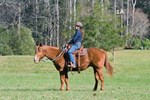
In Photo 1B, Goodnight’s lower leg is too far forward, and you can see her horse’s cinch. She calls this “chair position.” It would take a jagged line to connect her ear, shoulder, hip, and heel. This leg-forward position not only looks strange, but adversely affects your horse’s performance. His center of gravity is located just behind his shoulder and below his withers. Ideally, you’ll ride as close to that point as possible so that your weight is easy for him to carry.
When you’re balanced and sitting above your heels, you’re as close to this balance point as possible. When your legs slide forward, your weight shifts back and drives down into your horse’s back.
Your horse feels this uncomfortable balance shift just as you would if someone you carried on your back suddenly shifted back and pointed her legs toward your shoulders —the weight would become difficult to carry.
To find this optimum leg position and whole-body alignment, place your reins in one hand, hold your saddle’s horn or pommel with your free hand, stand up in the stirrups, and notice where your stirrups and legs are positioned. Also see whether you can easily balance without holding on.
When you can balance easily (it may take some practice), roll back onto your seat bones, sit up straight, and allow your legs to relax against your horse’s sides.If this position feels new and strange, ask a friend to watch you ride. Ask her to tell you when you have a perfect line between your heel, hip, shoulder, and ear, and when your leg drifts forward and out of balance.
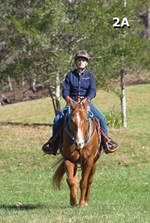
Sometimes, saddle design can contribute to a chair-seat position. For instance, if the stirrups hang in front of the seat’s center, the saddle will draw your legs forward. If your stirrups are too long (as they might be in an effort to reduce joint pain), it’s difficult to keep your leg underneath you. Pushing your heels down too far and leaning back on the cantle can also cause you to brace and push your legs forward.
Position Fix #2: Nix the Splits
In a relaxed and correct position, your lower leg hangs down from your knee and wraps around your horse’s barrel, softly caressing your horse’s sides (Photo 2A). Note that you can’t see much daylight between Goodnight’s leg and the horse’s side.
If your legs are too straight and you’re riding in “splits” position (Photo 2B), it’s time to relax and sit down on your seat bones. Riding with your legs far from your horse’s sides pushes you up out of the saddle, and off of your seat bones. Your whole body becomes tense and you lose the ability to cue your horse with subtle seat and leg cues.
You also tense your whole spine, which can cause your horse’s gaits to pound your spine and shoulders. Instead, allow your body to relax and go with your horse’s rhythmic flow.
And, while it’s good to ride with your heel below your toe so that your foot stays inthe stirrup, it’s not necessary to press yourlegs down and out. Doing so will cause your joints to lock and can cause ankle and knee pain.
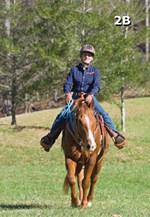
To find this optimum leg position, bend your knees, and relax if you feel the stirrup pressing against the bottom ofyour foot. Ask a friend to stand in front of you as you walk straight ahead, and alert you when you stiffen your legs.
Position Fix #3: Angle Your Ankles
Flex your toes and point them out just a little so that your foot is equally weighted in the stirrup across the balls of your feet. This slightly angled position (Photo 3A), called pronating, simply means to roll your ankle so that your feet and knees can relax as you ride.
This is key to comfort when you ride for long distances. The pronated position of your foot will realign the bones that comprise your ankle and knee joints as you ride — and can reduce joint pain.

Goodnight remembers being told as a child to keep her feet straight ahead as she rode. You don’t walk with your feet pointed straight forward; if you try, you’ll find it’s difficult to maintain your balance. Also, your hips and knees don’t move as fluidly as they should.
When you ride with your toes pointing straight ahead (Photo 3B), a position riding instructors used to drill as “proper” — you actually cause great stress on your joints. By relaxing your foot and following the stirrup angle, you’ll feel more relaxed on and off your horse.
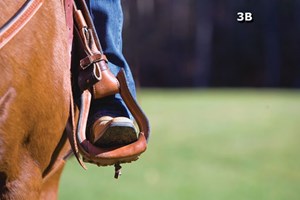
Position Fix #4: Arch No More
Keep your back relaxed, but straight (Photo 4A). If you concentrate too hard on your position and posture, it’s easy to overcompensate and ride incorrectly.
Goodnight often sees riders arch their backs when she asks them to sit up straight. The position forces a curve into your spine and forces you to sit too far forward and off your seat bones. It can quickly become tiring and is painful for both you and your horse if you trot. In this position, you’ll slam down onto your horse’s back and land on your crotch instead of your seat bones.
If you get nervous during your ride, or if your horse makes a sudden move and becomes difficult to control, it’s easy for your reflexes to kick in and move you into a perched position. With an arched back, your weight will shift forward, your legs will lift, and your hands will clench the reins.
This tense position transmits inadvertent signals to your horse, telling him to tense (or tense more), speed up, and possibly prepare for flight. This position also causes you to close your pelvis, which reduces your hips’ range of motion.
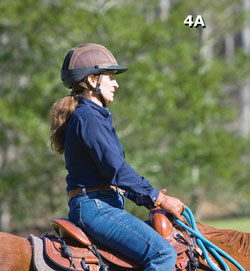
If you often ride with tension, this perched-forward position can cause soreness in your knees, hips, and seat. Instead, relax your back, suck your belly button toward your spine, and relax your lower back just as you do when you sit back into a car seat or easy chair. When your back is flat and relaxed, you’ll feel your horse’s back as he moves in his rhythmic gait. The rougher your horse’s gait, the more important it is that your back and legs are relaxed. Once your legs are relaxed, you’ll also be able to relax your hips, so they can absorb the lift in your horse’s back.
If you’re used to arching your back or riding in the perched-forward position, it may be difficult for you to feel where your posture is straight. You may feel like you’re leaning too far back when you’re actually correct.
Ask a friend to watch you ride to make sure your shoulders are directly over your hips, not in front of the ear-shoulder-hip-heel line.
Julie Goodnight (www.juliegoodnight.com) lives in central Colorado, home to miles of scenic trails. She trains horses and coaches horse owners to be ready for any event, on the trail or in the performance arena. She shares her easy-to-understand lessons on her weekly RFD-TV show, Horse Master, and through appearances at clinics and horse expos held throughout the United States. She’s also the international spokesperson for the Certified Horsemanship Association (www.cha-ahse.org).
Heidi Melocco (www.wholepicture.org) is a lifelong horsewoman, equine journalist, and photographer based in Mead, Colorado.






